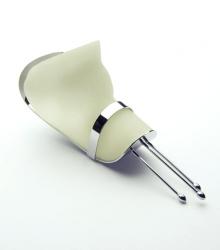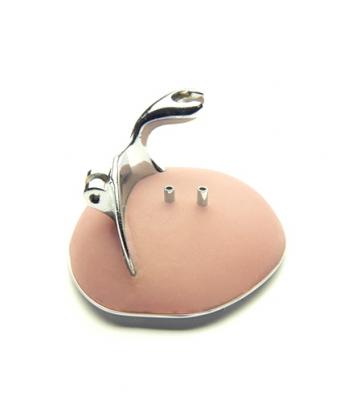
Susan Cummins: Can you tell the story of how you discovered that you wanted to be a jeweler?
Katja Prins: I think that the need to express oneself by creating things and using visual language is something that doesn’t come like a discovery or epiphany. It’s something that is just part of you, and it simply needs to have the opportunity to develop. I’ve always been interested in all kinds of art and have always liked to make things, so I just followed my heart.
As soon as I started my technical education as a goldsmith at Schoonhoven, it was clear to me that there was more. I wasn’t too interested in traditional jewelry, and so right away, I focused on going to the art academy. There wasn’t much about jewelry there, but much more about expressing yourself, developing a visual language, and telling an interesting story. It made me an artist whose medium happens to be jewelry.

Susan Cummins: Can you tell the story of how you discovered that you wanted to be a jeweler?
Katja Prins: I think that the need to express oneself by creating things and using visual language is something that doesn’t come like a discovery or epiphany. It’s something that is just part of you, and it simply needs to have the opportunity to develop. I’ve always been interested in all kinds of art and have always liked to make things, so I just followed my heart.
As soon as I started my technical education as a goldsmith at Schoonhoven, it was clear to me that there was more. I wasn’t too interested in traditional jewelry, and so right away, I focused on going to the art academy. There wasn’t much about jewelry there, but much more about expressing yourself, developing a visual language, and telling an interesting story. It made me an artist whose medium happens to be jewelry.
Was there a professor in particular who influenced you? Can you recall a particular interaction with that person that was helpful to you or moved you toward your current work?
Katja Prins: Not really, actually. All teachers have an influence one way or another. I’m a student of Ruudt Peters, and I’m sure he has had his influence on me, but maybe it’s more for the outsider to say how and in what way. I remember mostly that after graduation I just wanted to get out of that influence and find my own way and own voice. Over the years, I have been much more influenced by the art that I’ve encountered and the books that I’ve read: artists such as Mark Manders, Bernd & Hilla Becher, Tadao Ando, Saskia Olde Wolbers, Dieter Rahms, Andreas Gursky, and Joep van Lieshout; and books of thinkers/visionaries such as Peter-Paul Verbeek, Ray Kurzweil, and Sonia Arrison.

In the past, your work has resembled diagrams of organs or drawings for new kinds of implements or freeway systems. They looked like something familiar but were only fragments and so unclear in their intentions. Can you explain what your ideas were for them?
Katja Prins: For quite some time, my work has been about the relationship between us, as human beings (our human bodies), and technology. When you think of it, this relationship is really intimate. Just look around you. It’s everywhere. We sleep, sit, eat, drink, move, and live with it. We even connect with each other through it. We heal our bodies with it, alter it, sculpt it, and more and more improve and enhance ourselves by it. All this technology is changing our lives all the time. In the past, we were mostly focused on the outside world, and we have changed that a lot.
Nowadays, we are much more focused on our inner world, on our brains and bodies, and this is changing human society a lot. Think of plastic surgery, smart drugs that improve our memory, gene-, DNA-, and stem-cell technologies, robotics, and nanotechnology. A lot of these technologies actually started out as treatments and medications to heal people, bring something back to “normal,” but nowadays, it’s more about improving/enhancing people and making them better than “normal.”
These developments raise questions. What are all these improvements doing to our humanity? On the other hand, has technology made us less human?
This ambivalence intrigues me, and this is what I try to express in my work.
It’s a big fascination, and the different collections refer to different aspects of this story. In my visual language, I use images, shapes, and materials that refer to these things. Often, one can interpret them in different ways. My hope is that people can discover their own story. So, I steer clear of too many explanations and too much direct clarification.

Katja Prins: As an artist, it’s important for me to develop, so I always try to look for a new (or maybe more developed) visual language using different materials to tell another part of the story. So to me, the new collection isn’t all that different. The visual language and materials are different, but the topic (the ideas behind it) is still the same. I’m just telling another part of the story.
Did you work with anyone in the medical field to make this work?
Katja Prins: I have a connection at the VU hospital in Amsterdam, and they supply me with certain things. I have also been visiting a dental laboratory, but they don’t directly help me to make my work. It is more an indirect influence.
It doesn’t look like these brooches would be comfortable to wear. Did you intend for them to interact with the body in some other way besides being worn?
Katja Prins: Most of these brooches are actually pretty easy to wear, but of course, that depends on one’s own standards. To me, it’s important that a piece of jewelry is also interesting on it’s own, like a small sculpture. So in that way, I want them to interact in another way.
Why did you title the current show Hybrids?
Katja Prins: In biology, hybrid means “an offspring resulting from cross-breeding.” With our technologies, we are becoming more and more hybrid creatures, compositions of organism and technology. Aren’t we going too far? Should we set limitations on these developments? Aren’t we getting overconfident and arrogant, or like the ancient Greeks used to say, “hybris (hubris)?”

Katja Prins: My intention is to make something interesting, something that hopefully will intrigue the viewer and attract attention and make him or her wonder … after all, wonderment is one of the best emotions in life. We loose it over the years, as we get older and more experienced. My love for art can make me wonder like a child again. So, I hope to make people think about what they are looking at, how it’s all related, and how we are all related to these things that we create. I want to make them think about why they find these pieces scary to look at, and to question if it is all that scary.
Didn’t we always use technology as a way to survive? Aren’t we technological creatures? Isn’t technology a human thing? To me, technology and being humans are not separated from each other. But, I find it totally interesting that they look very different from each other, which results in a certain tension, and I like that. I’m not interested in plain beauty and comforting things. I like the poetry of being puzzled and confused. Things get so much more interesting when there’s some disturbance. After all, wasn’t it Lawrence Weiner who said “art is supposed to fuck everything up.”
Did you do a lot of research for this project, and was there a particular book you used? What else are you reading?’
Katja Prins: My topic is my overall fascination with life, and my research is ongoing. A lot of things that I do, read, visit, and see are related to this. There’s no beginning or end in my “research.” I have read a lot of books and articles related to my topic. One of the best lately was a book by Dutch technology philosopher Peter-Paul Verbeek De grens van de mens: over techniek, ethiek en de menselijke natuur (The limitations of human beings: about technology, ethics, and human nature).
And of course, the Internet and Google are the best research items there are. I can go on for hours, from one page to another link, get totally lost, and bump into the most interesting things.
I also had a trip when I read Cloud Atlas by the genius author David Mitchell.
Thank you.





